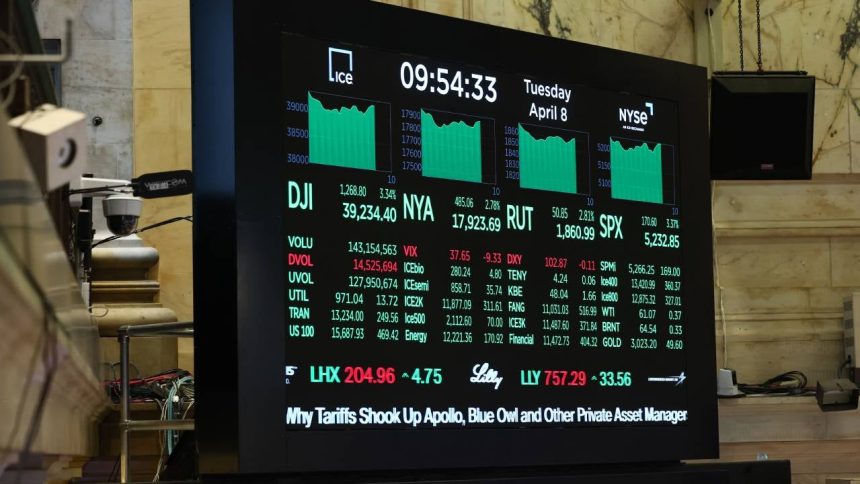It’s a question you’ll frequently hear during any program discussing the latest financial news: “What did the market do today?” The answer often includes a reference to an index such as the Dow Jones Industrial Average, the S&P 500 or the Nasdaq. But what are these? And what distinguishes one from the other?
What are the Dow, Nasdaq and S&P 500?
Before diving into the differences between the Dow vs. the Nasdaq vs. the S&P 500, it’s important to understand the key commonality among them: In this context, they are all referring to market indexes — not stock exchanges.
Each of these three major stock indexes tracks a certain subset of stocks, and the movements — day to day, month to month and year to year — offer a view of how the broader market is performing and the sentiment among investors.
Here are some key characteristics.
| Dow Jones | Nasdaq Composite | Nasdaq 100 | S&P 500 | |
|---|---|---|---|---|
|
Number of companies |
30 | 3,000+ | 100 | About 500 |
|
Criteria for inclusion |
U.S.-based companies trading on the Nasdaq or NYSE exchanges | Must trade on Nasdaq stock exchange | Largest non-financial stocks trading on Nasdaq | U.S.-based companies that trade on any U.S. stock exchange |
| Weighting | Price-weighted | Market-cap weighted | Market-cap weighted | Market-cap weighted |
|
Market representation |
Blue chip stocks | Tech heavy | Tech heavy | Broad, includes 80% of the value of publicly-traded U.S. companies |
|
ETFs that track the index |
SPDR Dow Jones Industrial Average ETF Trust (DIA) | Fidelity Nasdaq Composite Index ETF (ONEQ) | Invesco QQQ Trust (QQQ) | Vanguard S&P 500 ETF (VOO) • iShares Core S&P 500 ETF (IVV) • Schwab S&P 500 Index Fund (SWPPX) |
The Dow Jones Industrial Average
The Dow Jones Industrial Average — often shortened to the Dow — is the most well-known and longest-running market index. It’s been around since 1896, and it consists of 30 blue-chip, U.S.-based companies that trade either on the New York Stock Exchange or the Nasdaq exchange. Some of the largest publicly traded companies in the country — Apple, Coca-Cola, Home Depot and Nike, to name a few — are included in the Dow.
While the Dow carries plenty of historical significance, its limited scope of just 30 companies and the fact that the index is price-weighted rather than being weighted by the value of the company make it an unreliable barometer of the entire market.
When you hear about the Dow, some references may be intended to make the movement of the day seem more dramatic. Consider which of these headlines is bound to get more attention: “The Dow fell 390 points today,” or “The S&P 500 was down 50 points today.” In both cases, the decline is roughly 1 percent.
There is, however, a time when activity in the Dow is headline-worthy: when the makeup of those 30 companies changes. For example, in November 2024, the index replaced Intel with Nvidia. That’s a moment of prestige for the companies making their way into the index and a reflection of recent underperformance — or loss of relevance — for companies removed from the list.
The Nasdaq
At first glance, hearing “the Nasdaq” may feel a bit confusing because it is a stock exchange. However, the Nasdaq Composite and the Nasdaq 100 are both market indexes that represent the ups and downs of particular stocks that are listed on the Nasdaq exchange.
The Nasdaq Composite includes more than 3,000 stocks traded on the Nasdaq exchange, and the Nasdaq 100 includes 100 large non-financial stocks — Starbucks, Netflix, Tesla and PepsiCo, to name a few — traded on the Nasdaq. The Nasdaq indexes are usually cited as a reference to the performance of technology stocks, but stocks from various industries are included in the Nasdaq averages.
The S&P 500
The S&P 500 includes 500 large, U.S.-based publicly traded companies, including all those listed in the Dow Jones Industrial Average, regardless of the stock exchange that is home to their trading activity.
Though this index includes just 500 of the more than 6,000 publicly traded U.S. stocks, the S&P 500 tells a more complete story of what the market is doing than the Dow or Nasdaq 100. It represents about 80 percent of the value of all publicly traded companies in the U.S., according to S&P Global.
The S&P 500 weights companies by their total market capitalization (the stock price multiplied by the number of each company’s outstanding shares). This formula means that larger companies carry more weight than smaller companies. In fact, more than 25 percent of the value is in Apple, Microsoft, Nvidia, Amazon, Meta Platforms, Alphabet and Tesla.
Because the S&P 500 contains hundreds of large companies and represents the lion’s share of total stock market value, it is considered a much better gauge of how the market is performing, even though it excludes thousands of smaller and midsize companies. It’s important to note that the S&P 500 changes on a more frequent basis than the Dow as companies grow their way into the mix and other companies are no longer considered large enough to be included.
Many investors use low-cost index funds that track the S&P 500 as a way to participate in the stock market. There are more narrowly focused index funds available, but S&P 500 index funds are a simple way to get a diversified basket of stocks at a low cost.
Alternatives to the Dow, Nasdaq and S&P 500
The Dow, Nasdaq and S&P 500 aren’t the only games in town for understanding the market’s performance. The Wilshire 5000 is designed to represent the entire U.S. stock market, and the Russell 2000 is solely focused on small-cap stocks. While these less-established companies tend to carry greater potential for risk, they also offer what every investor wants: more room to grow and profit.
Bottom line
The Dow, Nasdaq and S&P 500 are major market indexes. The Dow tracks 30 large U.S. companies but has limited representation. The Nasdaq indexes, associated with the Nasdaq exchange, focus more heavily on tech and other stocks. The S&P 500, with about 500 large U.S. companies, offers a more comprehensive market view, weighted by market capitalization. Other indexes, like the Wilshire 5000 and Russell 2000, cover broader market segments.
— Bankrate’s Dayana Yochim contributed to an update.
Read the full article here
















